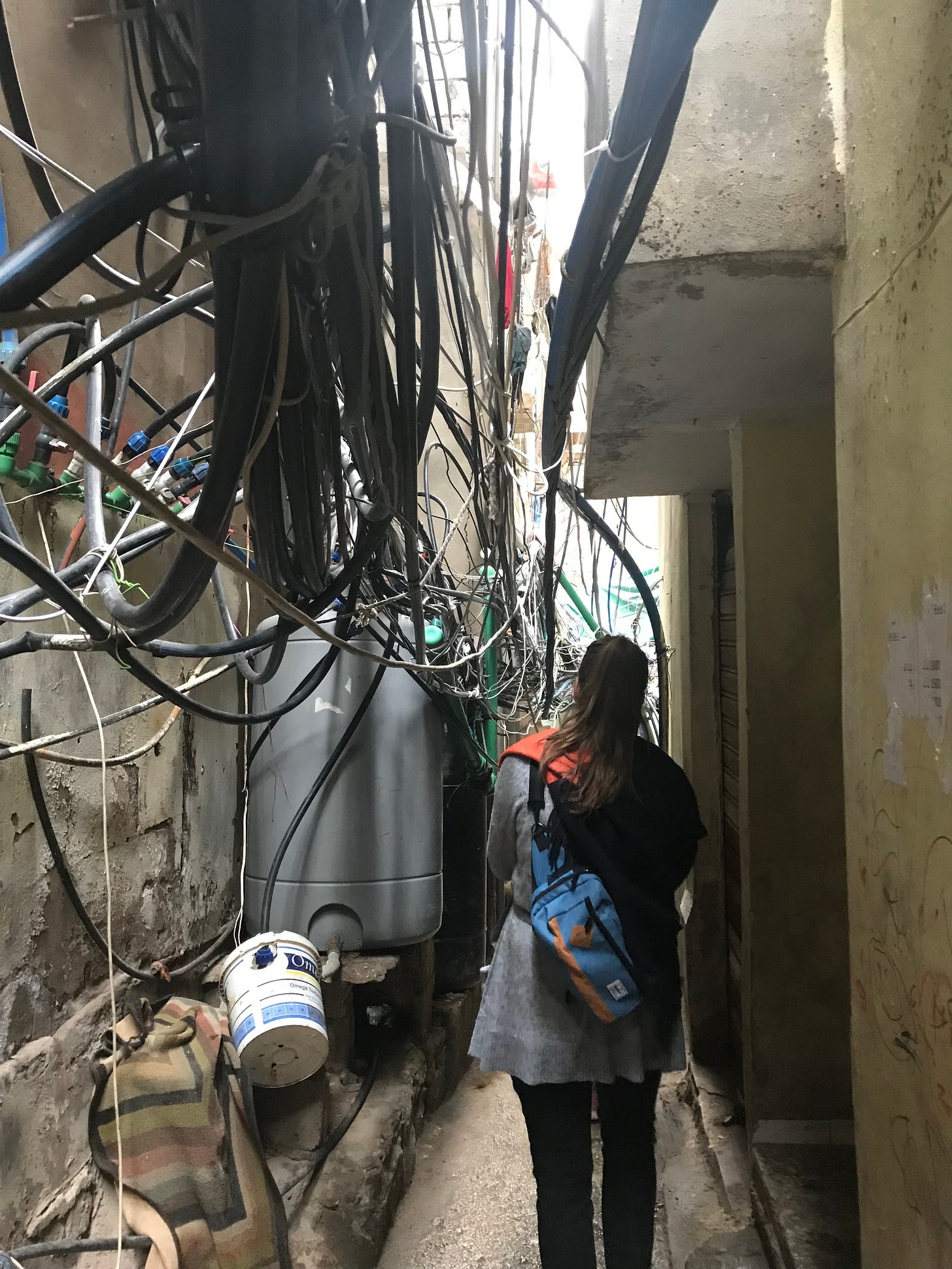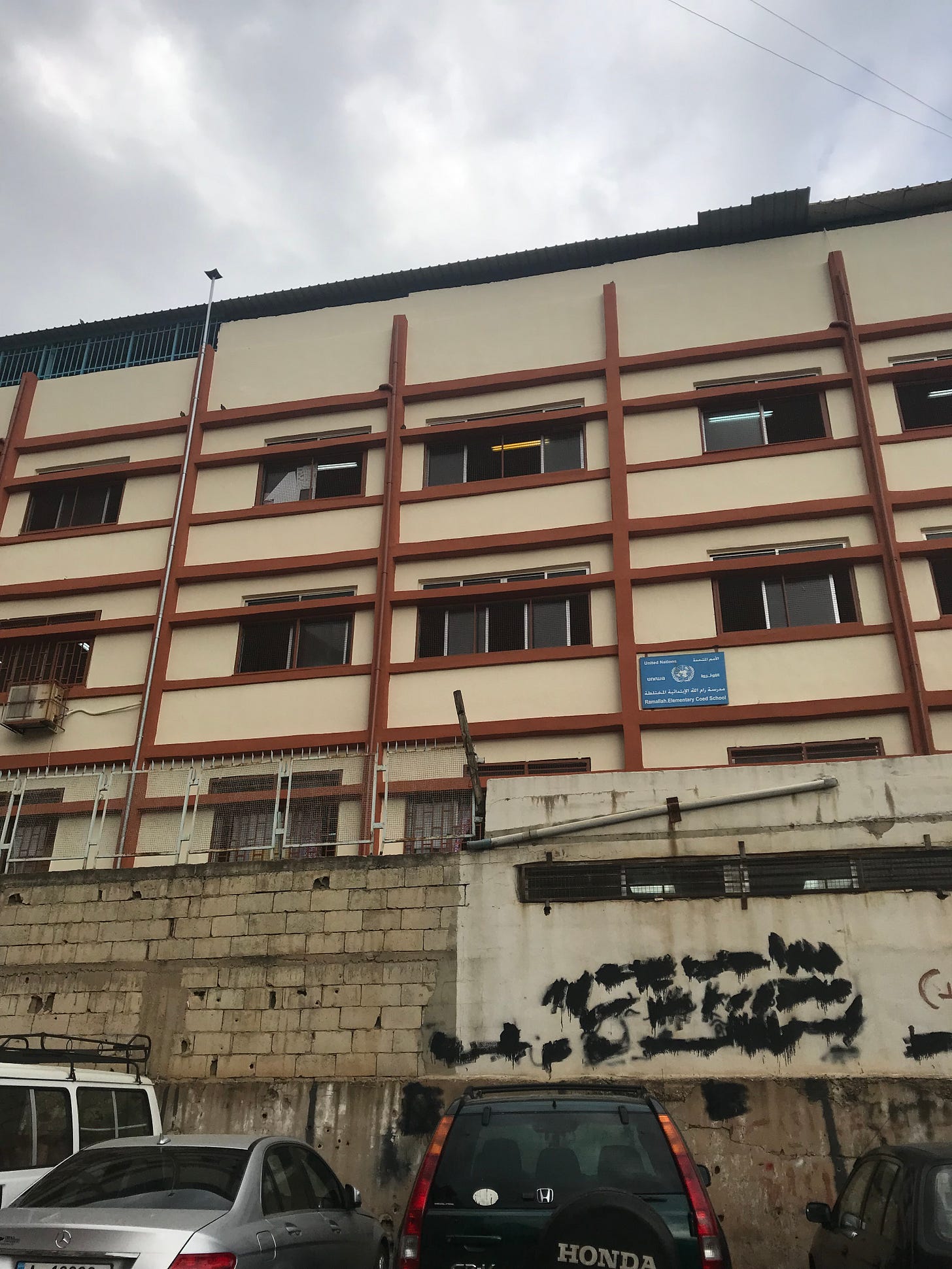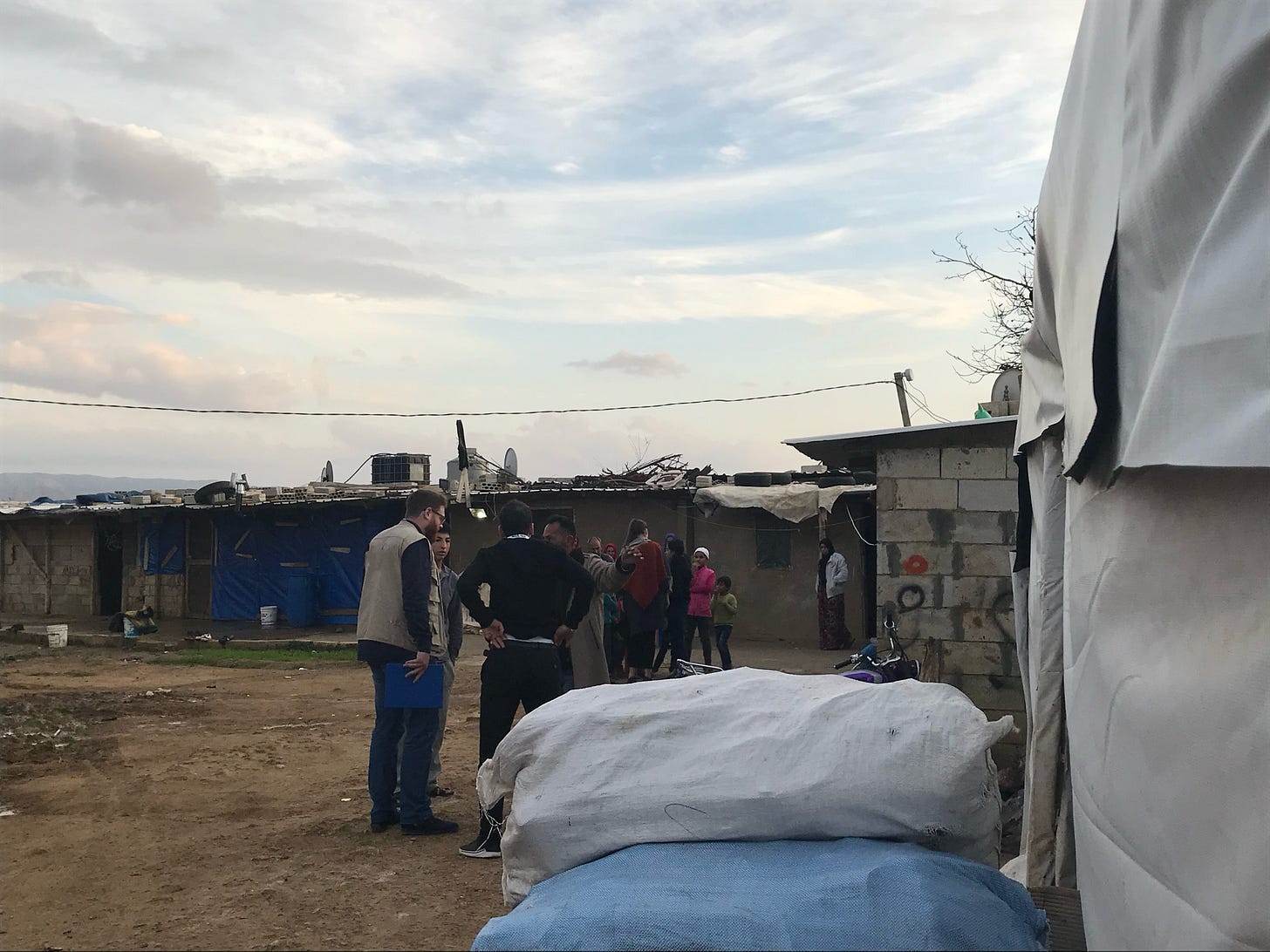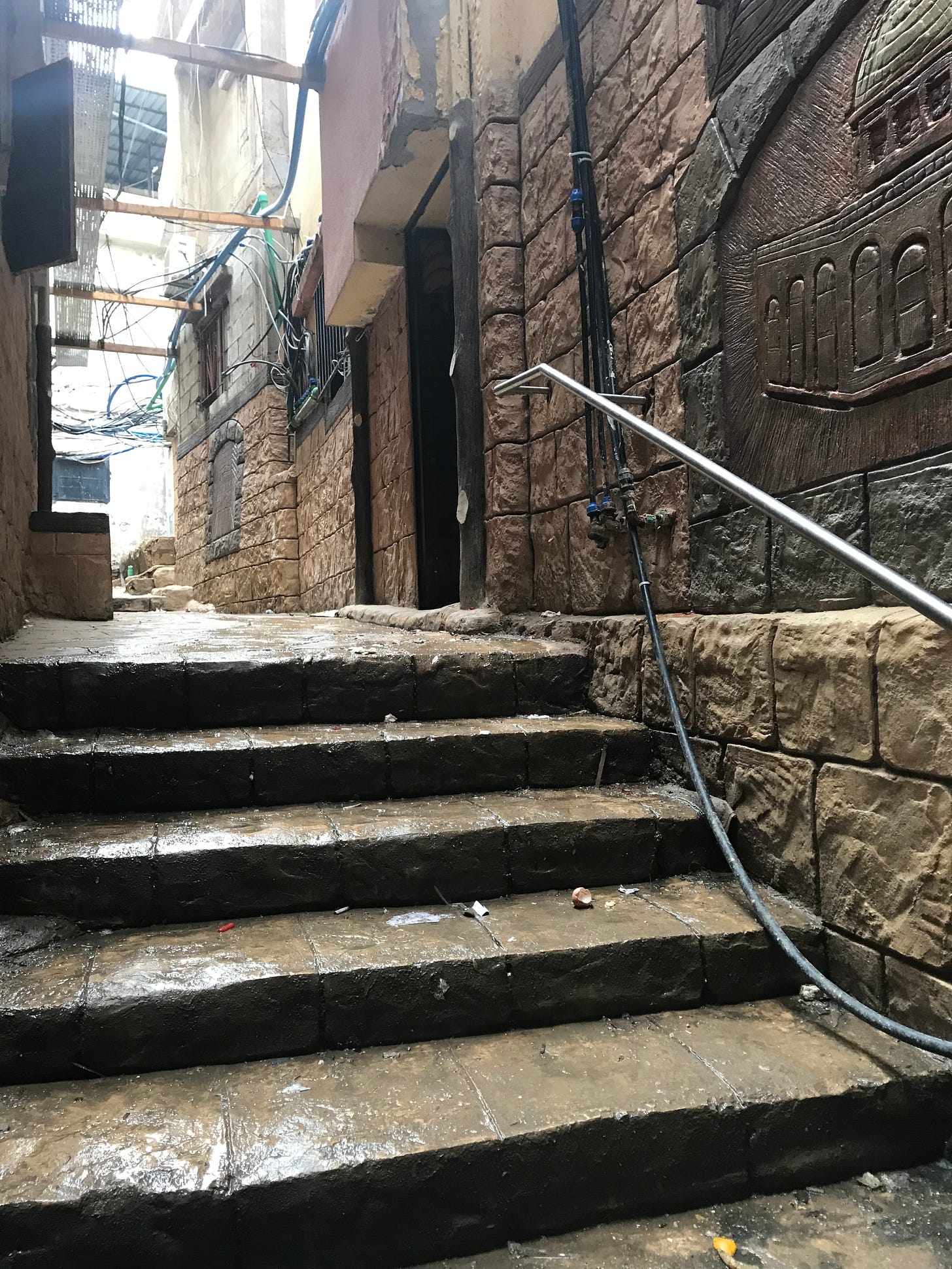Westerners have no idea about refugee camps and humanitarian aid.
In 2018, I visited two refugee camps in Lebanon, a place where Israelis are banned and Jews aren't welcome. What I saw shattered what I thought I understood about humanitarian aid.
Please consider supporting our mission to help everyone better understand and become smarter about the Jewish world. A gift of any amount helps keep our platform free of advertising and accessible to all.
This is a guest essay by Hether Warshauer, who writes the newsletter “Finding Simcha.”
You can also listen to the podcast version of this essay on Apple Podcasts, YouTube Music, YouTube, and Spotify.
Writer’s Note: This is a firsthand account of what I saw inside two refugee camps in Lebanon. It’s not a takedown of the NGO I worked for. It won’t offer policy recommendations, historical deep dives, or analyze the conflict. It’s not theory, and it’s not advocacy. And it’s definitely not a call for an end to international aid. It’s simply what I saw and heard alongside my unfiltered reactions.
On a chilly, overcast morning in December 2018, I stepped out of a car in Beirut and followed our guide through an arched entrance.
Just like that, we walked into Shatila, one of the world’s most infamous Palestinian refugee camps.
I’d spent the better part of a decade working in international development, reading and writing about places like this in proposals and reports. Being there, on the other hand, was different. In the end, it fundamentally changed how I think about international aid.
The first thing I noticed were all of the wires. They were everywhere: live and low-hanging, tangled overhead like vines in a jungle. Some dropped dangerously close to puddles, while others brushed the edges of rain barrels and drooped into damp corners. There was a faint buzzing in the air.
“A few kids die each year from electrical shocks,” our translator explained in a tone more akin to delivering a weather report than telling us about the leading cause of accidental death in the camp. “Everyone knows, but no one can fix it.”
There were three other things that stood out:
The patches of wet black paint on the wall of the UNRWA (UN Palestinian agency) school that presumably covered graffiti our handlers didn’t want us to see
Guns — there were weapons everywhere; large rifles; concealed, yet noticeable, handguns; a lot of people seemed to be armed
Posters of longtime Palestinian leader Yasser Arafat pasted on the walls alongside endless strings of Hezbollah banners; the flags fluttered in the breeze like we were at a party where no one was celebrating
Shatila is one of 12 refugee camps in Lebanon, set up by the Red Cross in 1949 to house about 500 households who fled following the establishment of the State of Israel. In the intervening years, the camp’s population has grown tremendously, and since 2009, it has also housed thousands of Syrian refugees. While there’s no official census, it’s estimated that the population is as high as 20,000.
The reality is not what well-meaning Westerners think of when they hear “refugee camp.” It’s neither a tent city nor temporary. It’s about a one square mile walled section of Beirut built haphazardly and vertically. Markets, clinics, schools, and apartments aer stacked on top of each other like a high-stakes game of Jenga.
We stepped through narrow alleyways, touring schools, clinics, and homes all while weaving past live wires and Palestine Liberation Organization flags. Eventually, I noticed that we were being watched and followed. One armed young man followed us at a distance, a rifle strapped to his chest with a finger not in the safety position but ever so slightly caressing the trigger. That’s when I stopped taking photos.
By my early 30s, I was working as a grant writer in international emergency response. When my NGO received $300,000 from an anonymous donor to improve housing for Syrian refugees in Lebanon, I joined the monitoring and evaluation team on a five-day site visit to camps in Beirut and the Beqaa Valley in Lebanon to report on how the grant funds were used.
Optimistic to a fault, I was oblivious to how potentially dangerous the situation was. Sure, I’d read the U.S. State Department travel warnings; kidnappings, disappearances, and murders of American citizens were real possibilities. In no uncertain terms, U.S. citizens were advised not to enter the camps. I’d completed the security briefing and skimmed the recommendations, figuring I’d be fine. I was going there for work.
My now-husband understood it differently. At the time, he was my boyfriend, but also an American-Israeli. Before I left, he quietly but seriously asked me if I was scared. (I wasn’t.) Then he asked me not to mention him during the trip. Not that we were dating, not that he was Israeli, and not that I was Jewish.
“Don’t say a word,” he said.
I didn’t fully understand what he meant. Honestly, I thought he was being weird and a bit dramatic. This was my job. In the car leaving Shatila that day, I saw it for what it was: a warning.
From Beirut, we drove east to the Beqaa Valley, past rolling hills of fertile farmland over quiet roads slick with drizzle. It’s a beautiful part of Lebanon, wide and open, with mountains in the distance. One thing I remember most was the chill in the air. It was the kind that sinks into your toes and doesn’t let up.
Here, the landscape looked more like what most people picture when they think of refugee camps. What started as tent cities, built to house thousands of Syrian refugees, evolved into villages constructed from tarps and spare wood, walls reinforced with repurposed scraps of sheet metal or old tires. There were some homes that were made of concrete, but most homes looked temporary, even though it was clear people had lived in them for years. There were makeshift kitchens, rugs laid over dirt floors, and plastic chairs set out for guests.
As we walked, I noticed that people moved slowly while some just stared past us. Children huddled around as we listened to the community leader’s greeting. A little girl, barely big enough herself, carried her baby brother across a flooded path like it was just part of the morning routine.
I saw a man standing outside his house with his arms crossed and a cigarette between his lips, looking toward the hills with a blank expression that I couldn’t place. Later, someone told me that man was from a Syrian village just on the other side of the mountains. On clear days, he could nearly see it, but he hadn’t been able to return home due to threats from the Bashar al-Assad regime, then in power.
The valley was quiet and beautiful, but there was a sadness that hung in the air. It seemed to be a place where people were suspended in an interminable wait to go back home.
Throughout the week, we met with beneficiaries, which a fancy term we use in international development for the people we are there to help. I sat through UNRWA presentations, met with various UN reps, and took diligent notes for donor reports.
The real story wasn’t in the PowerPoint presentations, the logic models, or the Gantt charts. It was “on the ground,” where people told us what they needed and what they had stopped hoping for. They talked openly about broken systems, broken trust, and what it felt like to be forgotten.
Every single person we met lived in a limbo they couldn’t escape because of politics and policies that keep them stateless. By Lebanese law, Palestinians are not permitted to have Lebanese ID cards, own property, or work in most professions — including construction. They cannot live outside the refugee camps. Unlike other refugee bodies like UN High Commissioner for Refugees or the UN-related International Organization for Migration, UNRWA doesn’t resettle refugees. It provides services while it maintaining the status quo, deferring to their host country.
Similarly, most of the 1.5 million Syrians in Lebanon lack legal status, also disqualifying them from education, healthcare, and formal employment.
The downstream impact of these policies was no more evident than in a conversation with a young mother in Shatila. She told us, through our translator, that she hoped her children, born to a Syrian father, would be eligible to enroll in a local school because he had legal status in Lebanon. Her logic was: Maybe they can go to school, maybe they can get out.
That moment hit me really hard. I realized the system I had spent years believing was so tangled in red tape and technicalities that people were left trapped, not helped.
One of the most bizarre things I saw was a $100,000 set of six stairs, a handrail, and a bronze plaque with the donor’s name. They cleaned up the wires for a ribbon cutting ceremony when they’d unveiled the new stairs, but more wires reappeared nearly immediately. The stonework was lovely, but the stairs were slick from constant running water, resulting in fall injuries to older people.
The stairs are a perfect symbol: What donors want to give and what communities need don’t always match.
Nearly every person we spoke to told us what they actually wanted in very plain language. They told us exactly what the problems were; I don’t know if they could have been any more specific. One mother wanted her children in school. One man wanted to return to Syria. Another was an engineer, trained in Damascus, who wanted to work in construction legally.
Instead, we were offering roof repairs and kitchen ventilation as people asked for school access, legal status, and a permanent home.
Just days earlier, I had landed in Beirut, wide-eyed, proud, and ready for my first international site visit. When the customs officer asked why I’d come, I said it with confidence: I was there with an NGO to help. But five days later, that confidence felt naïve and misplaced. The pride I’d carried had shifted into something else: confusion, and the growing sense that I had misunderstood a lot.
As a former Model UN nerd with a master’s degree in international affairs, I have a broader-than-average knowledge of the UN. I have always believed in the UN with its lofty vision, idealism, and nearly singular focus on peace. I’ve carried a pocket-size copy of the UN Charter and the Universal Declaration on Human Rights (alongside my pocket-size U.S. Constitution, for the record) through 12 moves because I’m hopelessly romantic about the inherent goodness of humanity.
I fundamentally believe in our institutions, but what I had previously seen as the UN’s commitment to neutrality seemed to be a façade. If this trip cracked the glass, the international community’s response to October 7th shattered it.
On the last night of our trip, everyone gathered at one of Beirut’s iconic restaurants, perched high above the sea. The Mediterranean stretched out into the dark as the waves crashed against the rocks below. Inside, we passed around grilled meats, mezze, and expensive French wine raising our glasses to a “successful site visit.”
I remember sitting at that table, trying to smile while also feeling deeply unsettled. My mind was racing, reconciling what I originally believed with what I’d witnessed over the past few days. On the plane back home, I realized what it was: disillusionment.
There isn’t a fix at the end of this story. I don’t have policy recommendations or a plan to issue a bold call for reform. I just have what I saw, heard, and can’t forget.
I saw a system (filled with earnest people who want to do good) that no longer pretends to work. I saw humanitarian aid that was more focused on appearances than on impact and dignity. I saw decades of people born into statelessness, and parents quietly praying their kids might be spared the same fate, not by peace and reconciliation, but by technicalities on a birth certificate.
This is my firsthand account of a system that’s been calcified by bureaucracy and politics, propped up by good intentions and bad incentives. It’s a system that, quite literally and figuratively, keeps people in place because moving forward would require too much of everyone involved.
For decades, we’ve called this humanitarian aid. But maybe we should start calling it managed despair.








So where did the billions and billions go? I imagine some NGOs do some good but it tend to believe the vast majority at best are opportunities for virtue signalers to show their compassion. The UN is at the top of the cesspool heap for not only do they not improve the lives of the "beneficiaries" but they moment jew hatred and keeping the beneficiaries down and uneducated ( UNRWA is all about indoctrination and we all know what or who the targets happen to be ( the events of Oct 7 & the subsequent discoveries make this crystal clear)). Every single US NGO should periodically be audited to determine if they fulfill their mission ( which is the basis for their tax exemption and other preferred status) and the extent to which their funds have been "misused" ( incuding excessive salaries and abuses on perks). This is especially true of any NGO that receives any government funding.
Very informative regarding the camps and the difficulties. I don't understand why no effort was made in the beginning to resettle the Palestinians. It was cruel to leave them in camps with no hope. I don't assign blame to Israel. In my book the UN, Western governments and Arab countries are all to blame.